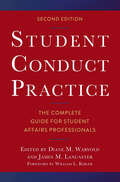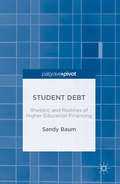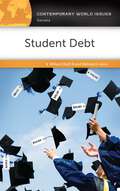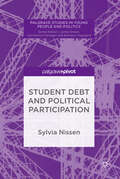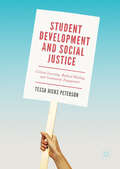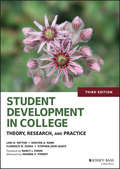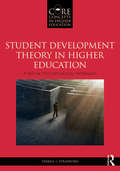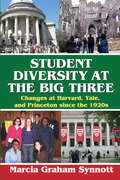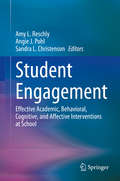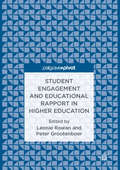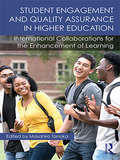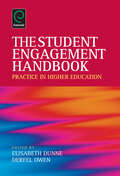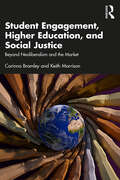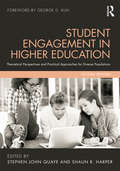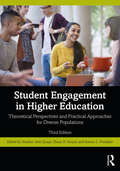- Table View
- List View
Student Conduct Practice: The Complete Guide for Student Affairs Professionals (Reframing Campus Conflict/student Conduct Practice Ser.)
by Diane M. Waryold, James M. LancasterSince the publication of the first edition of Student Conduct Practice in 2008 the landscape of student conduct has matured and shifted dramatically. As the composition of the overall population and of the student body on campuses across the nation has changed, institutions of higher learning have a greater awareness of the importance of preparing students to function competently in a diverse society. They are seeing student behaviors, such as challenging mores, rules and policies, that reflect the growing polarization and complexity we see in our larger society, and such trends as a marked increase in student mental health challenges as well as changing social dynamics, all of which require a new awareness and a rethinking of policies and responses by conduct professionals, including embracing the a social justice as a lens by which we perform our work.This updated and considerably expanded edition maintains the objectives of the first--to constitute a compendium of current best practices in the administration of student conduct, to summarize the latest thinking on key issues facing practitioners today, and to provide an overview of the role and status of conduct administrators within their institutions.This text invites student conduct administrators to examine current programs and policies to ensure that the spaces that they create during interactions with students are spaces in which all students feel welcome and heard. As we strive to prepare students not only to be productive members of today’s workforce, and more importantly to be good people and upright citizens, this text accentuates the delicate balance between responding to regulatory mandates and meeting the educational aims of student conduct. The aim is to offer those with an interest in student conduct and those professionals who are new or seasoned student conduct administrators with both a compendium of chapters on best practices and the background to grapple with the thought-provoking situations they will encounter. In close collaboration with the leadership of the Association for Student Conduct Administration (ASCA) the editors identified the most pressing conduct issues on our campuses and practitioners and faculty who offer related expertise and a necessary diversity of voices.This is also available as a set with Reframing Campus Conflict, Second Edition.
Student Conduct Practice: The Complete Guide for Student Affairs Professionals
Since the publication of the first edition of Student Conduct Practice in 2008 the landscape of student conduct has matured and shifted dramatically. As the composition of the overall population and of the student body on campuses across the nation has changed, institutions of higher learning have a greater awareness of the importance of preparing students to function competently in a diverse society. They are seeing student behaviors, such as challenging mores, rules and policies, that reflect the growing polarization and complexity we see in our larger society, and such trends as a marked increase in student mental health challenges as well as changing social dynamics, all of which require a new awareness and a rethinking of policies and responses by conduct professionals, including embracing the a social justice as a lens by which we perform our work.This updated and considerably expanded edition maintains the objectives of the first--to constitute a compendium of current best practices in the administration of student conduct, to summarize the latest thinking on key issues facing practitioners today, and to provide an overview of the role and status of conduct administrators within their institutions.This text invites student conduct administrators to examine current programs and policies to ensure that the spaces that they create during interactions with students are spaces in which all students feel welcome and heard. As we strive to prepare students not only to be productive members of today’s workforce, and more importantly to be good people and upright citizens, this text accentuates the delicate balance between responding to regulatory mandates and meeting the educational aims of student conduct. The aim is to offer those with an interest in student conduct and those professionals who are new or seasoned student conduct administrators with both a compendium of chapters on best practices and the background to grapple with the thought-provoking situations they will encounter. In close collaboration with the leadership of the Association for Student Conduct Administration (ASCA) the editors identified the most pressing conduct issues on our campuses and practitioners and faculty who offer related expertise and a necessary diversity of voices.This is also available as a set with Reframing Campus Conflict, Second Edition.
Student Debt: Rhetoric and Realities of Higher Education Financing
by Sandy BaumThis book analyzes reliable evidence to tell the true story of student debt in America. One of the nation’s foremost experts on college finance, Sandy Baum exposes how misleading the widely accepted narrative on student debt is. Baum combines data, research, and analysis to show how the current discourse obscures serious problems, risks misdirecting taxpayer dollars, and could deprive too many Americans of the educational opportunities they deserve. This book and its policy recommendations provide the basis for a new and more constructive national agenda to make paying for college more manageable.
Student Debt: A Reference Handbook (Contemporary World Issues)
by William Elliott III Melinda K. LewisOffering answers to essential questions about student debt and many connected issues, this book examines student debt in the United States at every stage of the process—from the banks that issue the loans to the colleges and universities that collect the payments.Student lending in the United States is one of the most controversial issues in contemporary American discourse. Are these loans the only option for Americans who want to attend college and university in order to attain the best careers and have a productive, enjoyable life? Should the predatory lending practices of for-profit colleges and universities be stopped? How can limits be imposed on student lending amounts without preventing students from getting the education they need to succeed?The book explains why so many students are borrowing large amounts of money to attend college; considers whether the cost of higher education is simply too high, and if there should be a cap on how much money students can borrow; explains what is contributing to the rising rate of borrowers defaulting on their loans; and predicts whether the so-called student loan bubble is in danger of popping. The Data and Documents chapter analyzes data gathered from discussions about student debt. This information enables readers to better understand who is borrowing student loans, what the money from the student loans is going toward, what individuals have the authority to decide who qualifies for these loans, and what is being done to curb wasteful student spending.
Student Debt: A Reference Handbook (Contemporary World Issues)
by William Elliott III Melinda K. LewisOffering answers to essential questions about student debt and many connected issues, this book examines student debt in the United States at every stage of the process—from the banks that issue the loans to the colleges and universities that collect the payments.Student lending in the United States is one of the most controversial issues in contemporary American discourse. Are these loans the only option for Americans who want to attend college and university in order to attain the best careers and have a productive, enjoyable life? Should the predatory lending practices of for-profit colleges and universities be stopped? How can limits be imposed on student lending amounts without preventing students from getting the education they need to succeed?The book explains why so many students are borrowing large amounts of money to attend college; considers whether the cost of higher education is simply too high, and if there should be a cap on how much money students can borrow; explains what is contributing to the rising rate of borrowers defaulting on their loans; and predicts whether the so-called student loan bubble is in danger of popping. The Data and Documents chapter analyzes data gathered from discussions about student debt. This information enables readers to better understand who is borrowing student loans, what the money from the student loans is going toward, what individuals have the authority to decide who qualifies for these loans, and what is being done to curb wasteful student spending.
Student Debt and Political Participation (Palgrave Studies in Young People and Politics)
by Sylvia NissenThis book examines how student debt informs the political action and participation of university students. The scale of student debt is unprecedented, particularly in the English-speaking world. In these democracies, debt has become an increasingly integral part of student life for many young people to enable participation in education and the wider economy. Using New Zealand as a case study, the author challenges existent assumptions about student attitudes towards loans by analysing how students speak about the impact of debt on themselves and their peers, including politically. Listening to these perspectives will provide a more nuanced insight into the underlying tensions and challenges of participating politically in a context of rising debt.
Student Development and Social Justice: Critical Learning, Radical Healing, and Community Engagement
by Tessa Hicks PetersonThis book weaves together critical components of student development and community building for social justice to prepare students to engage effectively in community-campus partnerships for social change. The author combines diverse theoretical models such as critical pedagogy, asset-based community development, and healing justice with lessons from programs promoting indigenous knowledge, decolonization, and mindfulness. Most importantly, this book links theory to practice, offering service-learning classroom activities, course and community partnership criteria, learning outcomes, and assessment rubrics. It speaks to students, faculty, administrators, and community members who are interested in utilizing community engagement as a vehicle for the development of students and communities towards wellbeing and social justice.
Student Development in College: Theory, Research, and Practice
by Lori D. Patton Kristen A. Renn Florence M. Guido Stephen John QuayeTHE ESSENTIAL STUDENT DEVELOPMENT REFERENCE, UPDATED WITH CUTTING-EDGE THEORY AND PRACTICE Student Development in College is the go-to resource for student affairs, and is considered a key reference for those most committed to conscious and intentional student affairs practice. This third edition includes new chapters on social class, disability, and emerging identity theories, with expanded coverage of faith and gender identity. A new framework provides guidance for facilitating dialogues about theory, teaching theory, and the importance of educators as consumers of theory. Discussion questions conclude each chapter and vignettes are woven throughout to provide practical context for theory. Learning activities in the appendix promote comprehension and application of theory. Get updated on the latest in student development theory and application Consider both the psychosocial and cognitive aspects of identity Learn strategies for difficult dialogues, and the importance of reflection Adopt an integrated, holistic approach to complex student development issues Student Development in College is the ideal resource for today's multifaceted student affairs role. "With five new or expanded chapters and critical updates throughout the text, this third edition expertly presents the complex, multifaceted, and continually evolving nature of the theories that inform scholars and professionals in their research and practice with college students. These authors, consummately aware of the needs of emerging and continuing student affairs professionals, have crafted a text that will be both eminently practical and intellectually engaging for graduate students, professionals, and faculty alike." —Dafina-Lazarus Stewart, associate professor, higher education and student affairs, Bowling Green State University "This third edition of Student Development in College beautifully presents the theoretical terrain of student development by honoring the foundational theories upon which the field was developed and foregrounding newer theories with brand new content and fresh perspectives. The result is a text that is comprehensive, sophisticated, and accessible—and one that is attuned to the contemporary realities of the complexities of student development." —Susan R. Jones, professor, higher education and student affairs, The Ohio State University
Student Development in College: Theory, Research, and Practice
by Lori D. Patton Kristen A. Renn Florence M. Guido Stephen John QuayeTHE ESSENTIAL STUDENT DEVELOPMENT REFERENCE, UPDATED WITH CUTTING-EDGE THEORY AND PRACTICE Student Development in College is the go-to resource for student affairs, and is considered a key reference for those most committed to conscious and intentional student affairs practice. This third edition includes new chapters on social class, disability, and emerging identity theories, with expanded coverage of faith and gender identity. A new framework provides guidance for facilitating dialogues about theory, teaching theory, and the importance of educators as consumers of theory. Discussion questions conclude each chapter and vignettes are woven throughout to provide practical context for theory. Learning activities in the appendix promote comprehension and application of theory. Get updated on the latest in student development theory and application Consider both the psychosocial and cognitive aspects of identity Learn strategies for difficult dialogues, and the importance of reflection Adopt an integrated, holistic approach to complex student development issues Student Development in College is the ideal resource for today's multifaceted student affairs role. "With five new or expanded chapters and critical updates throughout the text, this third edition expertly presents the complex, multifaceted, and continually evolving nature of the theories that inform scholars and professionals in their research and practice with college students. These authors, consummately aware of the needs of emerging and continuing student affairs professionals, have crafted a text that will be both eminently practical and intellectually engaging for graduate students, professionals, and faculty alike." —Dafina-Lazarus Stewart, associate professor, higher education and student affairs, Bowling Green State University "This third edition of Student Development in College beautifully presents the theoretical terrain of student development by honoring the foundational theories upon which the field was developed and foregrounding newer theories with brand new content and fresh perspectives. The result is a text that is comprehensive, sophisticated, and accessible—and one that is attuned to the contemporary realities of the complexities of student development." —Susan R. Jones, professor, higher education and student affairs, The Ohio State University
Student Development Theory in Higher Education: A Social Psychological Approach (Core Concepts in Higher Education)
by Terrell L. StrayhornMoving beyond the theories traditionally used to describe college student development, this engaging book introduces social psychological theories that address the most relevant issues in higher education today. Covering theories of ecological systems, sense of belonging, prejudice and discrimination, positive psychology, social capital, personality theory, mentoring, and hope theory, this book promotes the understanding and application of social psychological theories to various higher education contexts. Examples from diverse student populations encourage learners’ application to situations in their own contexts. Comprehensive enough to be used as a main text but accessible enough to be used alongside another, this important textbook bridges research, theory, and practice to help practicing and aspiring higher education and student affairs professionals effectively work with college students. Special Features Include: • Reflective exercises that combine theory and practice and help students apply their knowledge solving problems. • Case studies and scenarios for further connections to the reader’s university and college settings. • Guiding questions that encourage students to think beyond the current literature and practice. • List of further readings and references for readers to explore topics in more depth.
Student Development Theory in Higher Education: A Social Psychological Approach (Core Concepts in Higher Education)
by Terrell L. StrayhornMoving beyond the theories traditionally used to describe college student development, this engaging book introduces social psychological theories that address the most relevant issues in higher education today. Covering theories of ecological systems, sense of belonging, prejudice and discrimination, positive psychology, social capital, personality theory, mentoring, and hope theory, this book promotes the understanding and application of social psychological theories to various higher education contexts. Examples from diverse student populations encourage learners’ application to situations in their own contexts. Comprehensive enough to be used as a main text but accessible enough to be used alongside another, this important textbook bridges research, theory, and practice to help practicing and aspiring higher education and student affairs professionals effectively work with college students. Special Features Include: • Reflective exercises that combine theory and practice and help students apply their knowledge solving problems. • Case studies and scenarios for further connections to the reader’s university and college settings. • Guiding questions that encourage students to think beyond the current literature and practice. • List of further readings and references for readers to explore topics in more depth.
Student Diversity at the Big Three: Changes at Harvard, Yale, and Princeton Since the 1920s
by Marcia SynnottStrengthening affirmative action programs and fighting discrimination present challenges to America's best private and public universities. US college enrollments swelled from 2.6 million students in 1955 to 17.5 million by 2005. Ivy League universities, specifically Harvard, Yale, and Princeton, face significant challenges in maintaining their professed goal to educate a reasonable number of students from all ethnic, racial, religious, and socio-economic groups while maintaining the loyalty of their alumni. College admissions officers in these elite universities have the daunting task of selecting a balanced student body. Added to their challenges, the economic recession of 2008-2009 negatively impacted potential applicants from lower-income families. Evidence suggests that high Standard Aptitude Test (SAT) scores are correlated with a family's socioeconomic status. Thus, the problem of selecting the "best" students from an ever-increasing pool of applicants may render standardized admissions tests a less desirable selection mechanism. The next admissions battle may be whether well-endowed universities should commit themselves to a form of class-based affirmative action in order to balance the socioeconomic advantages of well-to-do families. Such a policy would improve prospects for students who may have ambitions for an education that is beyond their reach without preferential treatment. As in past decades, admissions policies may remain a question of balances and preferences. Nevertheless, the elite universities are handling admission decisions with determination and far less prejudice than in earlier eras.
Student Diversity at the Big Three: Changes at Harvard, Yale, and Princeton Since the 1920s
by Marcia SynnottStrengthening affirmative action programs and fighting discrimination present challenges to America's best private and public universities. US college enrollments swelled from 2.6 million students in 1955 to 17.5 million by 2005. Ivy League universities, specifically Harvard, Yale, and Princeton, face significant challenges in maintaining their professed goal to educate a reasonable number of students from all ethnic, racial, religious, and socio-economic groups while maintaining the loyalty of their alumni. College admissions officers in these elite universities have the daunting task of selecting a balanced student body. Added to their challenges, the economic recession of 2008-2009 negatively impacted potential applicants from lower-income families. Evidence suggests that high Standard Aptitude Test (SAT) scores are correlated with a family's socioeconomic status. Thus, the problem of selecting the "best" students from an ever-increasing pool of applicants may render standardized admissions tests a less desirable selection mechanism. The next admissions battle may be whether well-endowed universities should commit themselves to a form of class-based affirmative action in order to balance the socioeconomic advantages of well-to-do families. Such a policy would improve prospects for students who may have ambitions for an education that is beyond their reach without preferential treatment. As in past decades, admissions policies may remain a question of balances and preferences. Nevertheless, the elite universities are handling admission decisions with determination and far less prejudice than in earlier eras.
Student Engagement: Effective Academic, Behavioral, Cognitive, and Affective Interventions at School
by Amy L. Reschly Sandra L. Christenson Angie J. PohlThis book provides cutting-edge, evidence-based strategies and interventions that target students’ engagement at school and with learning. Coverage begins with the background and 29-year history of the Check & Connect Model and describes the model and assessment of student engagement that served as the backdrop for conceptualizing the engagement interventions described in the book. Subsequent chapters are organized around the subtypes of student engagement – academic, behavioral, affective, cognitive – that were developed based on work with the Check & Connect Model. Principles and formal interventions are presented at both the universal and more intensive levels, consistent with the Response-to-Intervention/Multi-Tiered System of Support (MTSS) framework. The book concludes with a summary on the lessons learned from Check & Connect and the importance of a system that is oriented toward enhancing engagement and school completion for all students. Interventions featured in this book include: Peer-Assisted Learning Strategies (PALS).The Homework, Organization, and Planning Skills (HOPS) Intervention.The Good Behavior Game in the classroom.Check-in, Check-out (CICO). Banking Time, a dyadic intervention to improve teacher-student relationshipsThe Self-Regulation Empowerment Program (SREP). Student Engagement is a must-have resource for researchers, professionals, and graduate students in child and school psychology, educational policy and politics, and family studies.
Student Engagement and Educational Rapport in Higher Education
by Leonie Rowan Peter GrootenboerThis book outlines a range of innovative methods to gather student feedback, and explores the complex relation between student engagement, student satisfaction, and student success. Drawing on results from a set of numerous case-studies carried out at a school of education, the book reports on a range of theoretically-informed teaching innovations, including focus groups, learning analytics data, collegial conversations and insights from student researchers, that have been designed to create respectful, student-centred, and engaging learning environments. In the current climate of ever-increasing pressure on delivering high student satisfaction rates, these results are invaluable for university students and teachers across the globe.With its unique thematic focus on educational rapport and relationship-centred education, the book is an excellent reference point for staff with a commitment to the scholarship of learning and teaching. It will be of great interest to students, practitioners, teachers and policy makers in higher education.
Student Engagement and Educational Rapport in Higher Education
by Leonie Rowan Peter GrootenboerThis book outlines a range of innovative methods to gather student feedback, and explores the complex relation between student engagement, student satisfaction, and student success. Drawing on results from a set of numerous case-studies carried out at a school of education, the book reports on a range of theoretically-informed teaching innovations, including focus groups, learning analytics data, collegial conversations and insights from student researchers, that have been designed to create respectful, student-centred, and engaging learning environments. In the current climate of ever-increasing pressure on delivering high student satisfaction rates, these results are invaluable for university students and teachers across the globe.With its unique thematic focus on educational rapport and relationship-centred education, the book is an excellent reference point for staff with a commitment to the scholarship of learning and teaching. It will be of great interest to students, practitioners, teachers and policy makers in higher education.
Student Engagement and Quality Assurance in Higher Education: International Collaborations for the Enhancement of Learning
by Masahiro TanakaUsing a range of international examples to compare the reality, purpose and effect of student engagement in universities across the globe, Student Engagement and Quality Assurance in Higher Education argues that teachers and students need to collaborate to improve the quality of university education and student learning. The growing trend of assessing and assuring quality in higher education is incredibly complex, as there are so many variables affecting both experiences and measures. With case studies from ten countries, covering a variety of cultural and environmental settings, this book focusses on ways of working with students to produce applicable, implementable strategies for universities the world over. Internationally applicable, this book presents ideas from a range of cultures, which can be adapted to be implemented in a variety of cultures. The reader is provided with a range of approaches where both the advantages and disadvantages are clearly presented. The ten case studies consider the macro, meso and micro levels of each approach, allowing for an exploration of the growing area of research and practice that is student–staff partnerships, showcasing ways of working with students to enhance engagement and quality, which are vital for a long-term approach. Focussing on one of the main reform topics for universities, Student Engagement and Quality Assurance in Higher Education is essential reading for educational researchers, institutional leaders and all concerned with the implementation and progression of student engagement and quality assurance in higher education.
Student Engagement and Quality Assurance in Higher Education: International Collaborations for the Enhancement of Learning
by Masahiro TanakaUsing a range of international examples to compare the reality, purpose and effect of student engagement in universities across the globe, Student Engagement and Quality Assurance in Higher Education argues that teachers and students need to collaborate to improve the quality of university education and student learning. The growing trend of assessing and assuring quality in higher education is incredibly complex, as there are so many variables affecting both experiences and measures. With case studies from ten countries, covering a variety of cultural and environmental settings, this book focusses on ways of working with students to produce applicable, implementable strategies for universities the world over. Internationally applicable, this book presents ideas from a range of cultures, which can be adapted to be implemented in a variety of cultures. The reader is provided with a range of approaches where both the advantages and disadvantages are clearly presented. The ten case studies consider the macro, meso and micro levels of each approach, allowing for an exploration of the growing area of research and practice that is student–staff partnerships, showcasing ways of working with students to enhance engagement and quality, which are vital for a long-term approach. Focussing on one of the main reform topics for universities, Student Engagement and Quality Assurance in Higher Education is essential reading for educational researchers, institutional leaders and all concerned with the implementation and progression of student engagement and quality assurance in higher education.
Student Engagement Handbook: Practice in Higher Education (0)
by Elisabeth Dunne Derfel OwenThere has been an unprecedented global surge in the numbers of young people going to university over the last few years and, for a multitude of different reasons, higher education worldwide is in a state of flux. To cope effectively, the universities of today will need to be more responsive to the needs of growing numbers of students and better attuned to their requirements. Many complex factors are driving strategic change and influencing institutional decision-making processes, but what is clear is that students are becoming increasingly fundamental to supporting change processes at both national and local levels, and that institutions are working in collaboration with students in new ways in order to understand and improve the learning environment. Within this context, 'student engagement' is the catch-phrase of the moment. This book highlights some of the national and global agendas and issues, from emerging sectors, to the meaning of student engagement for different stakeholders. It provides a backdrop to themes of student engagement as well as examples of innovative and inspiring means of engaging with students in practice, empowering them to take responsibility within decision-making processes and enabling them to lead and deliver change.
Student Engagement, Higher Education, and Social Justice: Beyond Neoliberalism and the Market
by Corinna Bramley Keith MorrisonStudent engagement is a catch-all term, irresistible to educators and policy makers, and serving many agendas and purposes. This ground-breaking book provides a powerful theory of student engagement, rooted in critical theory and social justice. It sets out a compelling argument for student engagement to promote social justice and to repel neoliberalism in, and through, higher education, addressing three key questions: Student engagement in what? Student engagement for what? Student engagement for whom? The answers draw on Habermas, Honneth, Gramsci, Foucault, and Giroux in examining ideology, power, recognition, resistance, and student engagement, with examples drawn from across the world. It sets out key features, limitations, and failures of neoliberalism in higher education, and indicates how student engagement can resist it. Student engagement calls for higher education institutions to be sites for challenge, debate on values and power, action for social justice, and for students to engage in the struggle to resist neoliberalism, taking action to promote social justice, democracy, and the public good. This book is essential reading for educators, researchers, managers and students in higher education, social scientists, and social theorists. It is a call to reawaken higher education for social justice, human rights, democracy, and freedoms.
Student Engagement, Higher Education, and Social Justice: Beyond Neoliberalism and the Market
by Corinna Bramley Keith MorrisonStudent engagement is a catch-all term, irresistible to educators and policy makers, and serving many agendas and purposes. This ground-breaking book provides a powerful theory of student engagement, rooted in critical theory and social justice. It sets out a compelling argument for student engagement to promote social justice and to repel neoliberalism in, and through, higher education, addressing three key questions: Student engagement in what? Student engagement for what? Student engagement for whom? The answers draw on Habermas, Honneth, Gramsci, Foucault, and Giroux in examining ideology, power, recognition, resistance, and student engagement, with examples drawn from across the world. It sets out key features, limitations, and failures of neoliberalism in higher education, and indicates how student engagement can resist it. Student engagement calls for higher education institutions to be sites for challenge, debate on values and power, action for social justice, and for students to engage in the struggle to resist neoliberalism, taking action to promote social justice, democracy, and the public good. This book is essential reading for educators, researchers, managers and students in higher education, social scientists, and social theorists. It is a call to reawaken higher education for social justice, human rights, democracy, and freedoms.
Student Engagement in Higher Education: Theoretical Perspectives and Practical Approaches for Diverse Populations
by Stephen John Quaye Shaun R. HarperStudent Engagement in Higher Education fills a longstanding void in the higher education and student affairs literature. In the fully revised and updated edition of this important volume, the editors and chapter contributors explore how diverse populations of students experience college differently and encounter group-specific barriers to success. Informed by relevant theories, each chapter focuses on engaging a different student population, including: low-income students, students of color, international students, students with disabilities, LGBT students, religious minority students, student-athletes, homeless students, transfer students, commuter and part-time students, adult learners, student veterans, and graduate students. The forward-thinking, practical strategies offered throughout the book are based on research and the collected professional wisdom of experienced educators and scholars at two-year and four-year institutions of higher education. Current and future faculty, administrators, and student affairs staff will undoubtedly find this book complete with fresh ideas to reverse troubling engagement trends among various college student populations.
Student Engagement in Higher Education: Theoretical Perspectives and Practical Approaches for Diverse Populations
by Stephen John Quaye Shaun R. HarperStudent Engagement in Higher Education fills a longstanding void in the higher education and student affairs literature. In the fully revised and updated edition of this important volume, the editors and chapter contributors explore how diverse populations of students experience college differently and encounter group-specific barriers to success. Informed by relevant theories, each chapter focuses on engaging a different student population, including: low-income students, students of color, international students, students with disabilities, LGBT students, religious minority students, student-athletes, homeless students, transfer students, commuter and part-time students, adult learners, student veterans, and graduate students. The forward-thinking, practical strategies offered throughout the book are based on research and the collected professional wisdom of experienced educators and scholars at two-year and four-year institutions of higher education. Current and future faculty, administrators, and student affairs staff will undoubtedly find this book complete with fresh ideas to reverse troubling engagement trends among various college student populations.
Student Engagement in Higher Education: Theoretical Perspectives and Practical Approaches for Diverse Populations
by Stephen John Quaye Shaun R. Harper Sumun L. PendakurIn the updated edition of this important volume, the editors and chapter contributors explore how diverse populations of students experience college differently and encounter group-specific barriers to success. Informed by relevant theories, each chapter focuses on engaging a different student population, including low-income students, Students of Color, international students, students with disabilities, religious minority students, student-athletes, part-time students, adult learners, military-connected students, graduate students, and others. New in this third edition is the inclusion of chapters on Indigenous students, student activists, transracial Asian American adoptee students, justice-involved students, student-parents, first-generation students, and undocumented students.The forward-thinking, practical, anti-deficit-oriented strategies offered throughout the book are based on research and the collected professional wisdom of experienced educators and scholars at a range of postsecondary institutions. Current and future faculty members, higher education administrators, and student affairs educators will undoubtedly find this book complete with fresh ideas to reverse troubling engagement trends among various college student populations.
Student Engagement in Higher Education: Theoretical Perspectives and Practical Approaches for Diverse Populations
by Stephen John Quaye Shaun R. Harper Sumun L. PendakurIn the updated edition of this important volume, the editors and chapter contributors explore how diverse populations of students experience college differently and encounter group-specific barriers to success. Informed by relevant theories, each chapter focuses on engaging a different student population, including low-income students, Students of Color, international students, students with disabilities, religious minority students, student-athletes, part-time students, adult learners, military-connected students, graduate students, and others. New in this third edition is the inclusion of chapters on Indigenous students, student activists, transracial Asian American adoptee students, justice-involved students, student-parents, first-generation students, and undocumented students.The forward-thinking, practical, anti-deficit-oriented strategies offered throughout the book are based on research and the collected professional wisdom of experienced educators and scholars at a range of postsecondary institutions. Current and future faculty members, higher education administrators, and student affairs educators will undoubtedly find this book complete with fresh ideas to reverse troubling engagement trends among various college student populations.
